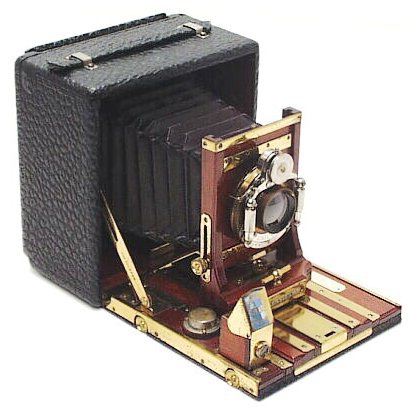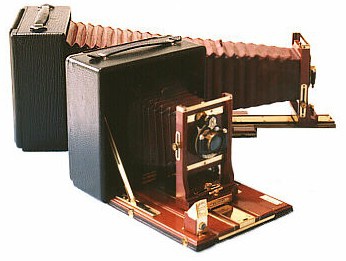|
|





5x7 Century Grand with traditional pebble grained
leather and uncommon celluloid shutter markers.
leather and uncommon celluloid shutter markers.
The self-casing, folding hand and stand camera is a unique creation in the
history of photographic apparatus -- a reflection of the American design
esthetic.
The design first appeared in the early 1880s with the Pearsall Compact camera, but it wasn't until the 1890 introduction of the No.4 Folding Kodak that these portable folding cameras gained broad public acceptance. And as can be seen by the endless variety of self-casing, folding dry-plate cameras appearing for sale at camera shows, the mid-1890s photographic community embraced these cameras.
One of the primary reasons for this popularity was because Kodak held numerous rollfilm system patents, thereby protecting their market and steering many competitors toward building plate cameras. The effect was dramatic. From 1894 to 1899, the number of companies making dry plate cameras doubled.
The design first appeared in the early 1880s with the Pearsall Compact camera, but it wasn't until the 1890 introduction of the No.4 Folding Kodak that these portable folding cameras gained broad public acceptance. And as can be seen by the endless variety of self-casing, folding dry-plate cameras appearing for sale at camera shows, the mid-1890s photographic community embraced these cameras.
One of the primary reasons for this popularity was because Kodak held numerous rollfilm system patents, thereby protecting their market and steering many competitors toward building plate cameras. The effect was dramatic. From 1894 to 1899, the number of companies making dry plate cameras doubled.
Yet by the turn of the century, popularity of folding dry-plate cameras declined as the number of rollfilm system cameras increased. The popularity
was well founded. Rollfilm cameras had the advantage of being much smaller and simpler, allowing the photographer to completely abandon
cumbersome double plate holders that had to be carried.
If I were to choose one camera as a classic representation of the self-casing style, it would be the Century Grand. No other camera was built with the fit, finish, and overall care as these cameras. Made of carefully selected mahogany woods, impeccable finish, red triple extension bellows, and polished brass fittings, the Century Grand was stately and elegant when compared to its peers. Even the smallest details weren't overlooked, such as the ivory aperture scale and maker's label on the brass lens.
If I were to choose one camera as a classic representation of the self-casing style, it would be the Century Grand. No other camera was built with the fit, finish, and overall care as these cameras. Made of carefully selected mahogany woods, impeccable finish, red triple extension bellows, and polished brass fittings, the Century Grand was stately and elegant when compared to its peers. Even the smallest details weren't overlooked, such as the ivory aperture scale and maker's label on the brass lens.
Grand Cameras, c.1901
Century Camera Company, Rochester, NY.
Century Camera Company, Rochester, NY.
Multi-Lens Cameras | View Cameras | Self-Casing Cameras | Solid Body Cameras | References & Advertisements
Home | What's New | Show Schedule | Wanted | For Sale | Links | Site Map | Email
Home | What's New | Show Schedule | Wanted | For Sale | Links | Site Map | Email
Copyright ©2001 by Rob Niederman - ALL RIGHTS RESERVED
Return to the Self-Casing Cameras page
Century cameras are not rare and numerous models were offered. Even today, not all Century cameras have been completely identified. Although the
examples shown here look very much alike, there are a number of subtle differences. One has traditional pebbled leather body and a friction rise/fall
lensboard while others have bear and seal-skin patterned leather, and a rack & pinion rise/fall lensboard. Drop-beds also differ: some have scalloped,
exposed wood edges while others have brass reinforcements on each side.
4x5 Century Grand with 'bear-skin' grained
leather body and traditional shutter.
A pair of 5x7 Century Grand cameras; one is fully
extended showing the draw of the triple extension bellows.
extended showing the draw of the triple extension bellows.